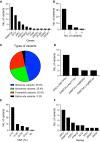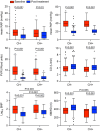Clonal Hematopoiesis in Chronic Thromboembolic Pulmonary Hypertension
- PMID: 39604025
- PMCID: PMC11681603
- DOI: 10.1161/JAHA.124.035498
Clonal Hematopoiesis in Chronic Thromboembolic Pulmonary Hypertension
Abstract
Background: The cause of chronic thromboembolic pulmonary hypertension (CTEPH) remains largely unknown. Recently, clonal hematopoiesis (CH) has been reported to be associated with cardiovascular and thromboembolic diseases. Here, we investigated the prevalence and clinical impact of CH in patients with CTEPH.
Methods and results: Whole-exome sequencing and deep-panel sequencing were performed in 214 patients with CTEPH. Clinical data before and after treatment were compared between patients with and without CH. RNA sequencing and serum analysis were performed to explore the pathogenesis that CH contributes to CTEPH. Among the enrolled patients, 20.1%, notably 44.4% who were 80 to 89 years old, had variants in CH-associated genes. In regard to clinical impact, B-type natriuretic peptide levels and home oxygen therapy rate were significantly higher, and 6-minute walk distance was significantly shorter after treatment in patients with CH than in those without CH. Moreover, novel clot reformation in the pulmonary artery despite the use of anticoagulants and additional angioplasty events after treatment completion were more frequent in patients with CH. RNA sequencing analysis revealed that blood coagulation and neutrophil extracellular trap formation pathways were enriched in patients with CH. Additionally, serum citrullinated histone H3 levels were higher in patients with CH than those without CH. These results were consistent in the subgroup of patients who did not have the history of hematological disorders.
Conclusions: The findings in this study raise the possibility that CH will induce a more prothrombotic state through neutrophil activation and neutrophil extracellular trap formation, contributing to pathogenesis and poor treatment response in patients with CTEPH.
Keywords: balloon pulmonary angioplasty; chronic thromboembolic pulmonary hypertension; clonal hematopoiesis; clot formation; neutrophil extracellular trap.
Conflict of interest statement
None.
Figures






References
MeSH terms
Substances
LinkOut - more resources
Full Text Sources
Medical

